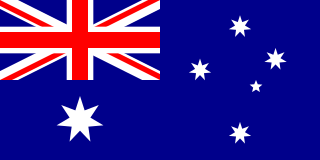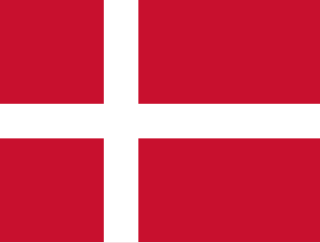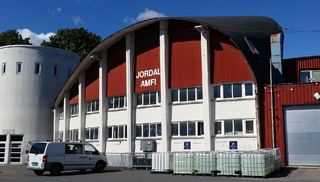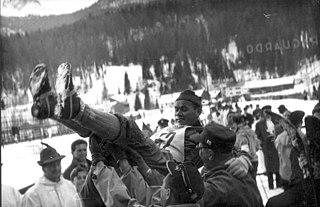
The 1952 Winter Olympics, officially known as the VI Olympic Winter Games and commonly known as Oslo 1952, were a winter multi-sport event held from 14 to 25 February 1952 in Oslo, the capital of Norway.

The 1956 Winter Olympics, officially known as the VII Olympic Winter Games and commonly known as Cortina d'Ampezzo 1956, were a multi-sport event held in Cortina d'Ampezzo, Italy, from 26 January to 5 February 1956.
The 1952 Winter Olympics, officially known as the VI Olympic Winter Games, took place in Oslo, Norway, from 14 to 25 February 1952. A total of 694 athletes representing 30 National Olympic Committees (NOCs) participated in the Games, taking part in 22 events from 6 sports.
At the 1952 Winter Olympics, three figure skating events were contested. Compulsory figures were skated at the outdoor Jordal Amfi rink, while the free skating portions of the competition were held at the huge Bislett Stadium, on a regulation-sized ice surface set inside the speed skating track. The competition opened with the ladies' figures on 16 and 17 February, followed by the men's figures on 19 February and then the three free skating events for ladies, men, and pairs. Somewhat unusually for competitions of this era, there were no particular problems with bad weather or poor ice conditions at the outdoor rinks. At this competition, Dick Button won his second Olympic title, and also became the first skater to land a triple jump—a triple loop jump—in competition.

Australia sent a delegation to compete at the 1956 Winter Olympics from the 26 January to 5 February 1956 in Cortina d'Ampezzo, Italy. This was the nation's third appearance at the Winter Olympic Games with their last appearance being in 1952.

Hayes Alan Jenkins is an American former figure skater. He is the 1956 Olympic champion, a four-time World champion (1953–1956), and a four-time U.S. national champion (1953–1956).

Denmark sent a delegation to compete at the 1952 Winter Olympics in Oslo, Norway from 14 to 25 February 1952. The kingdom was making their second appearance at a Winter Olympic Games. They were represented by one figure skater, second-time Olympian Per Cock-Clausen. In the men's singles' competition, he came in 14th and last place.

Jordal Amfi was an indoor ice hockey rink in Oslo, Norway, the first bearing that name. The venue opened in 1951 to host the 1952 Winter Olympics. Jordal was also the site of the 1958 and the 1999 IIHF World Championship. It would in the following decades also serve several boxing matches and concerts.
The women's figure skating competition at the 1956 Winter Olympics took place at the Olympic Ice Stadium in Cortina d'Ampezzo, Italy. The competition was held on 30–31 January and 2 February 1956. Twenty-one women from eleven countries participated in the competition. The event was dominated by the American skaters and who won gold and silver. Tenley Albright, who overcame a significant injury two weeks before the start of the competition, was the Olympic champion.
The figure skating pairs competition at the 1956 Winter Olympics took place on 3–4 February. The Austrian pair of Sissy Schwarz / Kurt Oppelt won the competition. Pairs from Canada and Hungary took second and third respectively. The pairs competition was the last figure skating event of the Olympics. It was held out doors at the Olympic Ice Stadium in Cortina d'Ampezzo, Italy, the host city for the Games.
The men's giant slalom at the 1956 Winter Olympics was held on 29 January on Mount Faloria, outside Cortina d'Ampezzo, Italy. The course on the Ilio Colli run was 2.660 km (1.65 mi) in length, with a vertical drop of 623 metres (2,044 ft). There were 71 gates for the men to navigate on the course. Ninety-five men from twenty-nine countries entered the race though eight were disqualified. Austrian men swept the medals.
The men's figure skating competition at the 1956 Winter Olympics took place at the Olympic Ice Stadium in Cortina d'Ampezzo, Italy. The competition was held on 29 January and 1 February 1956. Sixteen men from eleven countries participated in the competition. The event was dominated by the American skaters who swept the medals. Hayes Jenkins and his brother, David Jenkins, won gold and bronze respectively.

The men's 30 km cross country race at the 1956 Winter Olympics took place on 27 January. It was held at the Snow Stadium, which was about 2 km (1.2 mi) from Cotrina. Fifty-one competitors from eighteen countries participated in the event. Finnish skier Veikko Hakulinen won the event by only 24 seconds over Swede Sixten Jernberg. Hakulinen and Jernberg would switch positions on the podium in the 50 km (31 mi) event. Russian skier Pavel Kolchin won the bronze in the 30 km (19 mi) event and also in the 15 km (9.3 mi) event.
The ladies' 10 kilometre cross-country race at the 1956 Winter Olympics was held on 28 January. It was held at the Snow Stadium, which was about 2 km (1.2 mi) from Cortina. Thirty-seven competitors from eleven countries participated in the event. The Soviet Union won the top two spots when Lyubov Kozyreva edged teammate Radya Yeroshina by 5 seconds. Swede Sonja Edström won the bronze.
The men's 15 kilometre cross-country race at the 1956 Winter Olympics was held on 30 January. It was held at the Snow Stadium, which was about 2 km (1.2 mi) from Cortina. Sixty-one competitors from twenty countries participated in the event. The Nordic countries of Norway and Sweden took first and second in the form of Hallgeir Brenden of Norway and Sixten Jernberg of Sweden. This was Jernberg's second silver medal of the Games. Soviet skier Pavel Kolchin won his second bronze of the Games.
The men's 50 kilometre cross-country race at the 1956 Winter Olympics took place on 2 February. It was held at the Snow Stadium, which was about 2 km (1.2 mi) from Cotrina. Thirty skiers from thirteen countries participated in the event. The Nordic countries once again dominated the event. In a reversal of the top two results in the 30 km (19 mi) race, Swedish skier Sixten Jernberg won the gold, Fin Veikko Hakulinen took the silver and Russian Fedor Terentjev won the bronze. Jernberg would go on to win a bronze in the relay event giving him a full complement of gold, silver and bronze. Hakulinen would win a silver in the relay event giving him a gold and two silver medals for the Olympics.
The men's 4 × 10 kilometre relay at the 1956 Winter Olympics took place on 4 February. It was held at the Snow Stadium, which was about 2 km (1.2 mi) from Cotrina. Fourteen teams and fifty-six skiers participated in the event. The Soviet team won the event. Finland came in second and Sweden took the bronze.

The 1952 Winter Olympics were held in and around Oslo, Norway, from 14 to 25 February 1952. Ten competition and eight non-competition venues were used, in addition to three designated, but unused, reserve competition venues. Six of the competition venues were located in Oslo, while one each was located in Bærum, Skedsmo, Drammen and Krødsherad. Bislett stadion was the centerpiece of the games, hosting the opening and closing ceremonies, the speed skating and the figure skating. Bislett featured both a 400-meter (1,300 ft) circumference speed skating track and a 60-meter (200 ft) long rink used for figure skating, separated by snow banks. Two reserve venues were designated for the skating events, Tryvann stadion in Oslo and Hamar stadion in Hamar.

Olav Tveten was a Norwegian architect.










